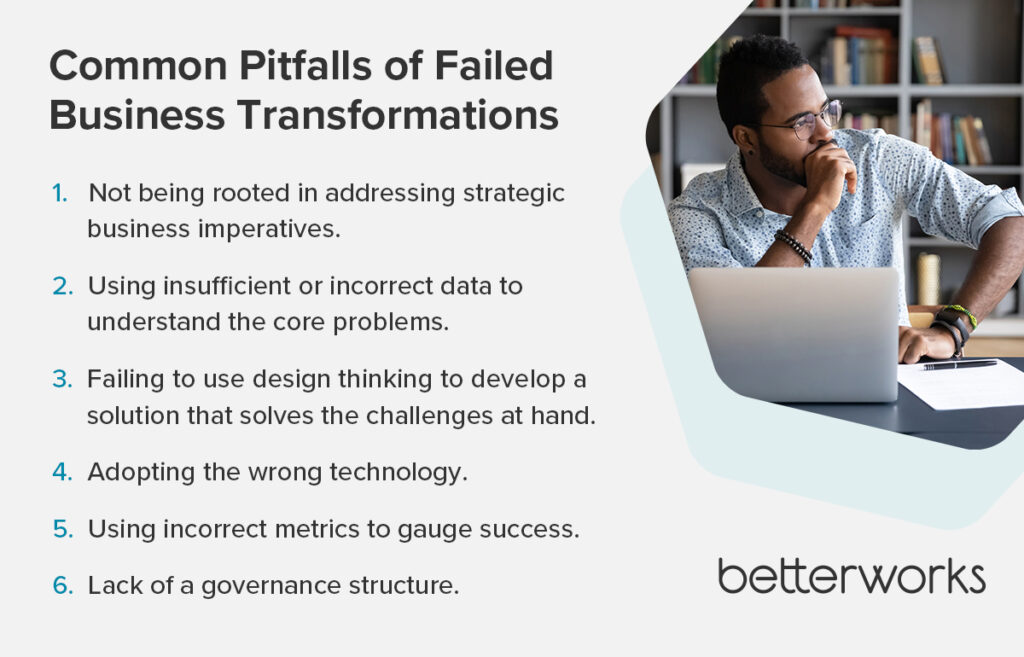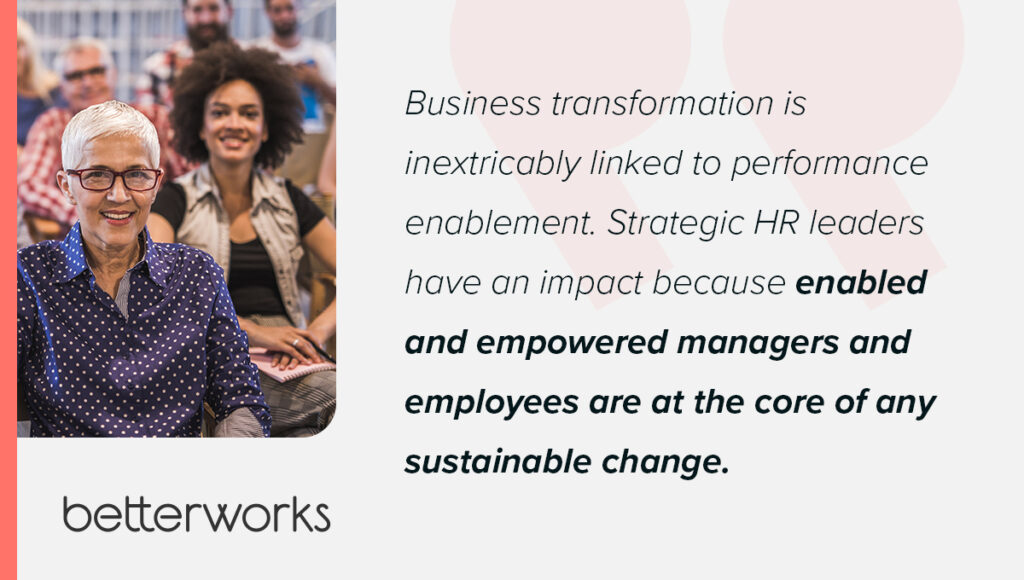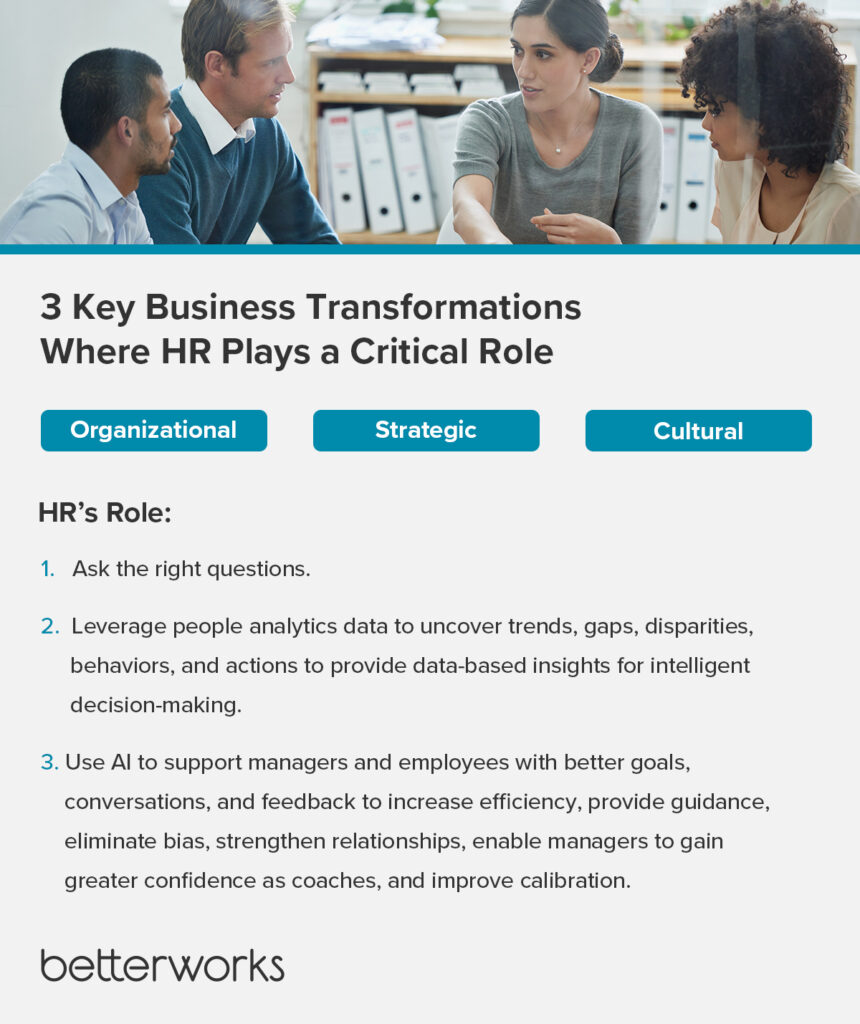- Why do business transformations fail?
- The link between business transformation and Intelligent Performance Management
- 3 types of business transformations
- Organizational transformation: Aligning and executing enterprise goals
- Strategic transformation: Prioritizing diversity, equity, inclusion and belonging
- Cultural transformation: Establishing a feedback and coaching climate
- Culture is at the crux of business transformations
- HR leaders are the nexus of business transformation
As I think about HR Professionals Day and the recognition due to every hard-working HR leader (You have earned it!), I’ve come to the conclusion that what I want for every one of you goes beyond recognition. HR should be empowered, valued, and respected — not only for all you have done for your companies and the many business transformations you’ve been part of — but for your growing strategic role in helping lead those business transformations.
I’ve said it before, and I’ll say it again: Now is your time. You are critically important to the success of your companies.
The profile of HR is elevated now more than ever before, and your role is becoming increasingly sophisticated. Data analytics, generative AI, hybrid and dispersed workforces, and the changing dynamics of how people view work and their expectations of employers place HR leaders front and center as never before.
Truly strategic HR leaders always focus first on pursuing transformations connected to achieving their organizations’ strategic business imperatives. Not the other way around. Rather than trying to maneuver a desired initiative to fit a strategic business outcome, these HR leaders look first at what the business needs to accomplish, then apply their deep understanding of the workforce to help achieve those objectives in a mutually beneficial way to the company and employees. Essentially, strategic HR leaders make the business case for the transformation.
As people leaders, the energy and effort you place into elevating employees and meeting the demands of an ever-evolving and competitive business environment should bear fruit. Yet, all too often, I have seen organizational transformations of one sort or another fail to stick over time.
“Truly strategic HR leaders always focus first on pursuing transformations connected to achieving their organizations’ strategic business imperatives. Not the other way around.”
Why do business transformations fail?
It can be downright discouraging to you, your team, and your leadership to see large and expensive transformation initiatives fail. People can become jaded and distrustful when these changes fall short, are abandoned, or become a never-ending stream of pilots and “initiatives.”
Some HR leaders and professionals have thrown in the proverbial towel. I get it. Rolling a stone uphill like Sisyphus is exhausting. Where’s the top? Do we ever get to enjoy watching the stone roll downhill on the other side, gaining speed without immense effort? Or do we just watch the stone catapult down the hill back toward us?
Even an initially successful business transformation has to be sustainable. A recent McKinsey Global Survey found that while 56% of respondents said their organizations have achieved most or all of their transformation goals, only 12% reported that they have sustained these goals for more than three years. Moreover, companies lose 42% of the potential financial benefit from business transformations during the execution of the large-scale change effort and post-transformation. Ouch!
Business transformations often fail for several reasons. They may include:
- Not being rooted in addressing strategic business imperatives.
- Using insufficient or incorrect data to understand the core problems.
- Failing to use design thinking to develop a solution that solves the challenges at hand.
- Adopting the wrong technology.
- Using incorrect metrics to gauge success.
- Lack of a governance structure.
This news may be discouraging, but I bring it up as a way of laying the foundation for approaching change strategies with the right mindset, preparation, tools, and data — to help you create a road map for business transformation.
By having a solid foundation, you’ll achieve short-term “implementation” success and long-term success that will help the company achieve its big, hair, audacious goals. Sustainable business transformation means that we’re able to move past the point of change to ensure that the transformation stabilizes and grows organically. It generates value that lives long after project teams disperse and evolves into a characteristic that helps define the company — a diverse and innovative company, a transparent and fair culture, a caring organization that is dedicated to taking care of its employees and customers.
Companies undertake business transformations to achieve a higher level of progress, whether it’s employee performance, manager performance, or organizational performance. HR is uniquely positioned to inform these transformations with data points: performance ratings, employee-manager conversations, engagement and eNPS ratings, skills and competencies, compensation and rewards, feedback, recognition, goals, and calibration.

The link between business transformation and Intelligent Performance Management
Having delivered organizational development, cultural transformation, and employee engagement strategies to increase people’s performance for over 25 years, I see clearly that these transformations depend upon a motivated, empowered workforce.
Business transformation is inextricably linked to performance enablement. Strategic HR leaders have an impact because enabled and empowered managers and employees are at the core of any sustainable change.
Working at Betterworks as the VP of HR Transformation, I’ve seen how companies can use Intelligent Performance Management (IPM) as a huge lever to positively affect the employee experience. Betterworks IPM infuses the people-centric and forward-looking capabilities of continuous performance enablement with the intelligence of generative AI and data analytics to drive organizational impact. It accomplishes this by simplifying performance management for all, fostering greater manager effectiveness, and enabling an organization to make smart, data-based decisions.
IPM focuses not on performance processes but on the activities and behaviors that enable people to improve at work continuously: frequent and meaningful manager-employee conversations, honest feedback among peers, agile and transparent goal-setting, and recognition that rewards positive actions and accomplishments. By observing these activities and behaviors and collecting the rich data generated by these interactions, HR is perfectly positioned to ask the right questions and share data that informs business transformations.

3 types of business transformations
I’ve been talking about business transformation as a catch-all term, but it comprises three categories: organizational, strategic, and cultural. HR leaders play a central role in all three.
First, let me give you some definitions.
Organizational transformation
Organizational transformation is the restructuring or realigning of business units. From a performance management perspective, the goal is to ensure that all employees are aligned with the organization’s transformation goals, strategies, and expectations. Examples of this type of transformation include mergers and acquisitions, movement into new lines of business or markets that necessitate changing the reporting structure, and restructuring that may happen after a reduction in force.
Strategic transformation
Strategic transformation involves redefining an organization’s strategy to adapt to changing market dynamics and achieve long-term goals. It typically addresses the fundamental direction and scope of the business and aims to ensure the organization’s long-term viability and competitive advantage.
In terms of performance management, it is necessary that teams and employees be able to modify or change their goals in agile and transparent ways and that changes in direction are communicated across the organization so that everyone is in sync. Strategic transformation may involve entering new markets or geographies, diversifying product offerings, pursuing innovative business models, or repositioning the company relative to its competitors.
Cultural transformation
Cultural transformation focuses on shifting individuals’ beliefs, values, behaviors, and mindsets within an organization. It aims to create a new organizational culture that supports the desired strategic objectives and adapts to changes in the internal and external environment.
From a performance management view, this change can happen when an organization has a workforce with strong, trustworthy, and healthy relationships between managers and employees and among employees or commits to this goal and follows through. Cultural transformation often involves fostering collaboration, encouraging innovation, promoting transparency, improving communication, and enhancing employee engagement.
Each type of transformation contains elements of the others, but they will predominantly fall into one type. They all begin with asking the right questions and having the right data.
How AI and analytics aid business transformation
AI and data analytics allow HR to act with surgical precision when it comes to understanding what’s causing the core challenges the business is trying to solve – in other words, the source of the illness, not the symptoms.
AI and data analytics have a pivotal role in shortening discovery time, providing best practices and recommendations for action, eliminating the unconscious bias we all carry, connecting the dots among disparate data to identify opportunities, and uncovering previously unknown trends, strengths, and weaknesses. Leveraging AI and data analytics provides the science needed to make informed decisions and help you sustain the transformation across your workforce.
While the drivers and data to be acquired will vary according to the specific type of transformation, here are three examples that illustrate the kinds of questions to ask and how to use data analytics and AI to your advantage.

Organizational transformation: Aligning and executing enterprise goals
Let’s say your leadership team has begun acquiring additional organizations to augment its core business. Job one for an HR leader is to ensure that all existing and new employees are aligned with the new entity’s goals, strategies, and expectations.
Characteristics of the performance management process the company will need to focus on include:
- The ability to provide tools and resources to help managers effectively set quality employee goals.
- Ensuring managers have an easy way to engage in meaningful conversations with their employees to ensure everyone understands how their contribution aligns with the new entity.
- Giving managers data-based insights into their team’s engagement and performance to improve retention.
Before embarking on a transformation, you would want to know the answers to the following questions, which can be answered by data analytics embedded in your performance management software:
- What are the main drivers of performance improvement? In other words, how adept are managers at properly assessing performance talent?
- Which employees and teams don’t have goals aligned with company objectives?
- How good are our various managers in assessing performance accurately?
HR can use data analytics to uncover clusters of high- and low-performing employees to determine where and why gaps in manager competency affect performance or ratings.
To help you establish a performance management process with the characteristics you desire, you can leverage AI as a co-pilot in your solution to support employees and managers at the goal-development stage with writing goals to ensure they’re optimized and aligned with the company’s strategic objectives. AI can also provide managers with a comprehensive and accurate assessment of their employees, versus a standard performance review, which often contains recency biases and other biases and is likely not comprehensive. In this way, AI serves as a coach, helping managers gain confidence over time and better guide their direct reports.
Strategic transformation: Prioritizing diversity, equity, inclusion and belonging
Imagine a scenario in which your enterprise is expanding into new geographies and needs to hire employees in multiple countries to serve an expanding customer base. As the chief people officer, you must ensure that your workforce is diverse, reflects your customer base, and that your policies and practices are culturally sensitive, fair, and inclusive.
As you look to reinforce your approach to DEIB, workplace actions you want to focus on include:
- Fostering inclusive conversations.
- Recognizing diverse contributions.
- Promoting fairness in professional growth.
- Supporting managers in giving bias-free feedback.
As you begin planning for this major change, you would seek answers to these questions from your data analytics engine:
- Are we equitable in the way we manage and develop our employees?
- Are there disparities in performance evaluations or promotion rates among different groups?
- Is diversity represented at all levels of leadership?
- Is employee turnover balanced across demographics?
Using data analytics, you can discover where there may be pockets of bias and the source of it. Data analytics can also help you identify high-potential and diverse employees for leadership roles and ensure they get the support they need from their managers.
Once you’ve completed your transformation, you can leverage AI in performance management to remove unconscious biases from the manager-employee relationship and promote bias-free coaching. AI can detect biased language to improve the quality and tone of feedback and reviews to ensure that employees view performance evaluations as fair. AI can also summarize all conversations, feedback, and goals to develop unbiased performance reviews, leading to a fair calibration process dictated by the science of data, not opinion.
Cultural transformation: Establishing a feedback and coaching climate
With the rapid pace of technological change, your head of Engineering approaches you to replace a top-down work environment with one that is more open and focuses on feedback and coaching. She believes that with a properly staffed and skilled team that is able to fail fast and adapt, she can unleash the rapid innovation and agility needed to help the business compete.
Your engineering chief wants a transformation that manifests itself in:
- Coaching for creativity and cross-functional collaboration.
- Continuous improvement for better performance and results.
- Coaching to guide the development of new skills needed for the business.
Before getting started, you could extract analytics data from your performance management system to address these questions:
- What skill gaps exist today?
- How much feedback and coaching is happening across the various business units?
- Is the coaching moving the needle on employee and organizational performance?
- Do people managers feel that they are well-equipped and supported as coaches?
Data analytics can help you uncover where and what skill gaps you have. You can also discover, for example, whether there are links between employees’ skills acquisition and manager coaching and whether teams that incorporate skill-building into their performance plans have more high performers.
Once the new approach is in place for your Engineering team (and ideally across your entire organization), you can use AI to ensure you and the engineering leader are getting the results you expect. You can take advantage of AI to identify feedback patterns and issues that require fixing, support managers in giving more actionable, bias-free feedback and coaching, and recommend targeted training and development programs to bridge identified skill gaps.
Culture is at the crux of business transformations
Truthfully, this last example is one that I see many organizations grappling with. It is at the core of the other business transformations. We must get the people fundamentals right.
We want our managers to have much stronger skills around coaching and feedback because relational skills are central to healthy organizations now more than ever. HR practitioners are responsible for enabling managers to be coaches and holding managers accountable when these behaviors are not adopted. This change won’t happen overnight. We have to allow managers to build competency through discussions and feedback, and we can’t achieve this when managers are engaged in performance discussions with their direct reports only twice a year. Frequency builds competency. The goal is to create an environment where manager-employee conversations happen continuously. When accomplished, we remove the angst and stress for managers and employees alike. We nurture an environment where conversations and feedback are authentic, timely, valuable, and done with the intent of removing roadblocks and improving performance outcomes.

HR leaders are the nexus of business transformation
As your enterprise’s workforce and employee experience leader, you have a unique perch from which to see and understand the needs of your people and the business — and to connect the two. It is a powerful platform for leading business transformations. When you can leverage your vantage point, data analytics, and AI, you will stand at the top of that hill and roll the boulders straight down, again and again.
Want to learn more? Read 9 Ways HR Leaders Can Lead Workforce Transformation.
As VP of HR Transformation at Betterworks, Jamie helps customers reimagine the way employee performance is managed with proven systems and processes that work. She is co-author of the book, Make Work Better, and draws inspiration from her more than twenty-five years of HR leadership experience, spearheading organizational development, HR transformation, and employee engagement strategies that boost business performance.
What are the components of strategic HR leadership?






